THE MYSTERY OF LIFE IN ANA ALBERTINA DELGADO’S WORK
The Museum of Contemporary Art of the Americas presented the exhibition Women Who I Could’ve Been, featuring the latest work of renowned artist Ana Albertina Delgado.
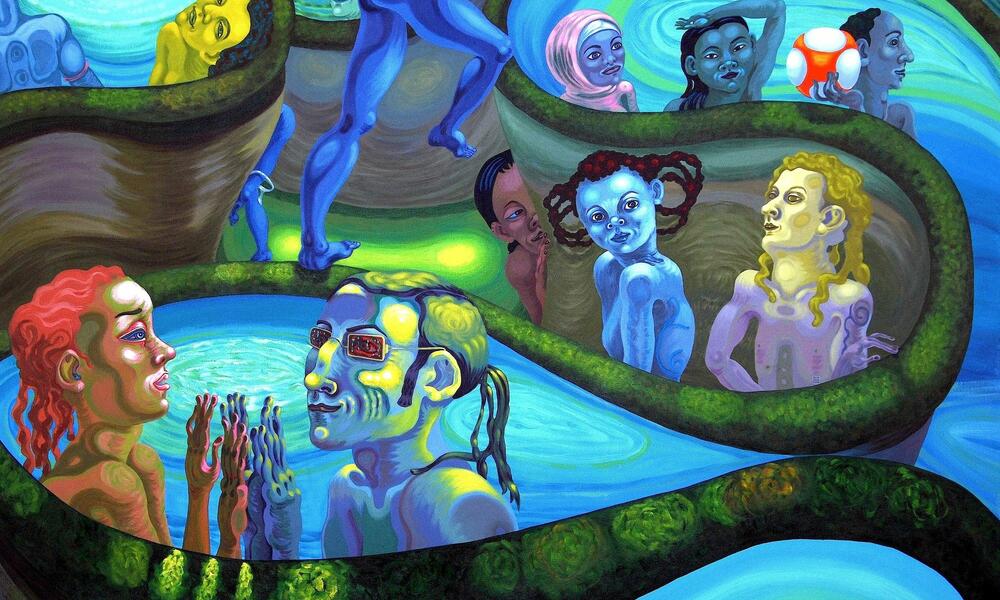
Ana Albertina Delgado’s work has been part of the Museum of Contemporary Art of the Americas for several years and has been featured in numerous group exhibitions both within galleries and at art institutions across South Florida, but Women Who I Could’ve Been marks her first solo exhibition at the museum, with 12 magnificent paintings of various formats, offering viewers a unique and intimate look at her latest creations.
Ana Albertina Delgado uses her pictorial language to express the current social debates surrounding diversity, emphasizing the role of women in society. With her paintings, Delgado builds human scenarios as metanarratives that reflect upon the construction of quotidian life while visualizing the social and psychological links between members of society. She takes the temperature of her times, using her artistic tools to build a conversation surrounding social progression and change. Her characters are ambiguously connected to one another through their enigmatic abilities and capacity for seduction, often expressed through sexuality, as they explore the mystery of life. Like a skilled fiction writer, Ana Albertina Delgado isolates the distinguishing qualities of her subjects and then amplifies those qualities visually and thematically in a way that celebrates humanity’s potential. While indistinctly, she takes as references urban mythology, as well as traditional country stories and myths.
Her paintings reveal the oddness of everyday life and the rebellious spirit that lurks within us all. Viewers can find themselves identifying with her subjects, no matter how extreme. Delgado’s bold use of color and accomplished pictorial technique is attention-grabbing; the richness of her thematic exploration secures it. Each painting is a narrative, a novel on canvas, complete with lead players, supporting cast, and flowing alongside the remarkable technical currents a dynamic plot that entertains, enlightens, and enchants.
Born in Havana, Cuba in 1963, Ana Albertina Delgado graduated in 1979 from San Alejandro National School of Fine Arts in Havana, Cuba's (oldest fine arts high school) and in 1983 from ISA Higher Institute of Arts in Havana, Cuba. Delgado was a prominent figure in the Generation of the Eighties in Cuba, participating in numerous group exhibitions across the globe, including Colombia, Venezuela, Mexico, Finland, Germany, France, Spain, and the United States. In 1986, she co-founded the artistic group "Pure" alongside four colleagues: José Buergo, Ciro Quintana, Ermy Tano, and Lázaro Zaavedra. "Pure" made significant contributions to Cuban culture by introducing innovative aesthetic concepts, collaborative artwork creation, and social critique themes. Delgado's specific contribution was addressing women's issues in Cuban society, combining empathy, motherhood, and societal positivity. She incorporated elements from Afro-Cuban and countryside culture avoiding clichés and revitalizing the fantastic aspects of Latin and Caribbean cultures, with a close link with modern painting intertwined with mythos, creation and death.
Related Topics
May interest you
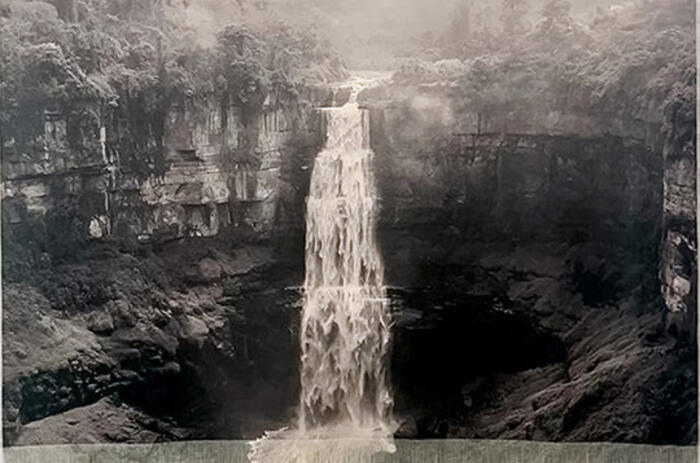
By Álvaro de Benito
The Madrid branch of La Cometa gallery presents during July the work of eight of its Ibero-American artists in a group show that delves into different languages and techniques, from ceramics to painting, and also includes dialogues with architecture and other productions. Three of those represented come from Spain, while of the five American representatives, four are Colombian and one is Cuban, which brings a representative vision of the gallery's artistic proposal closer to the spectator.

By Álvaro de Benito
The Madrid branch of La Cometa gallery presents during July the work of eight of its Ibero-American artists in a group show that delves into different languages and techniques, from ceramics to painting, and also includes dialogues with architecture and other productions. Three of those represented come from Spain, while of the five American representatives, four are Colombian and one is Cuban, which brings a representative vision of the gallery's artistic proposal closer to the spectator.
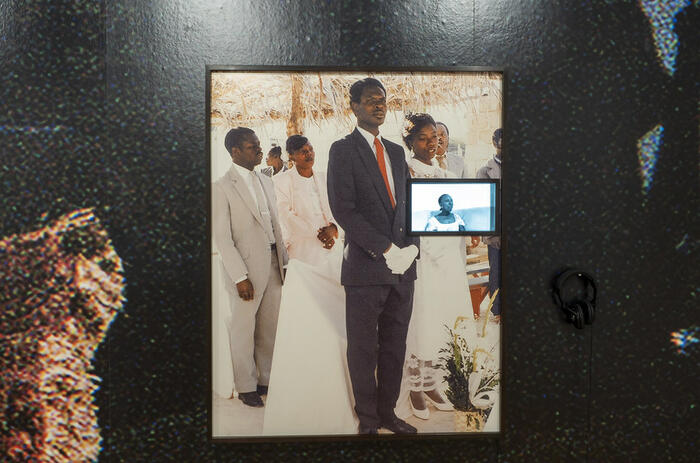
Widline Cadet (Pétion-Ville, Haiti, 1992) brings together in her life experience several of the aspects and themes that, perhaps, have inspired more production among all those curatorial lines with more presence. Her biography, constructed through childhood memories, the environment of a generation and a country marked by its own strong culture or the phenomena of emigration, constitutes the framework in which the photographer develops the practical integrity of her work.
MEMORY AND DIASPORA IN WIDLINE CADET
Widline Cadet (Pétion-Ville, Haiti, 1992) brings together in her life experience several of the aspects and themes that, perhaps, have inspired more production among all those curatorial lines with more presence. Her biography, constructed through childhood memories, the environment of a generation and a country marked by its own strong culture or the phenomena of emigration, constitutes the framework in which the photographer develops the practical integrity of her work.
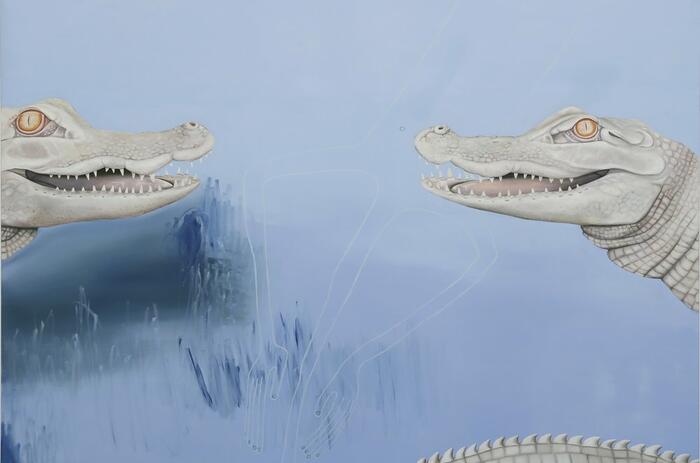
All sauce, No shrimp is Sophie Ullrich’s anticipated solo exhibition at Piero Atchugarry. The artist presented a new collection of site-specific paintings and sculptures that entwines modern folklore and scientific inquiry.
AN UNDERWATER KINGDOM – SOPHIE ULLRICH EN PIERO ATCHUGARRY
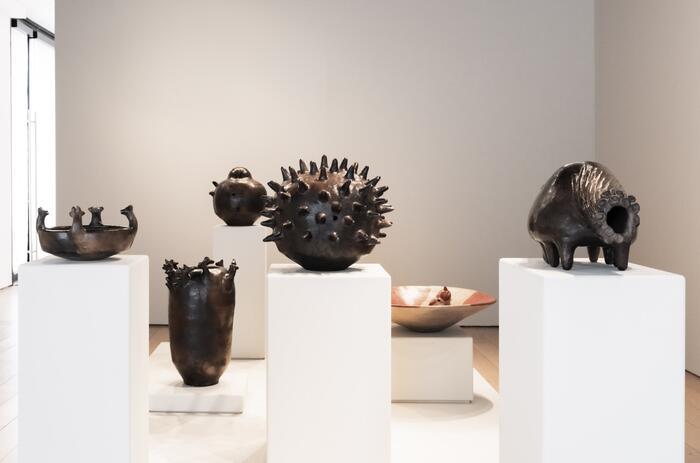
Kasmin gallery presented Mundo de Julia, an exhibition of ceramic sculpture by Julia Isídrez. This is the artist’s first solo exhibition in the United States and runs concurrently with Isídrez’s presentation in Stranieri Ovunque – Foreigners Everywhere, the 60th International Art Exhibition of La Biennale di Venezia curated by Adriano Pedrosa.
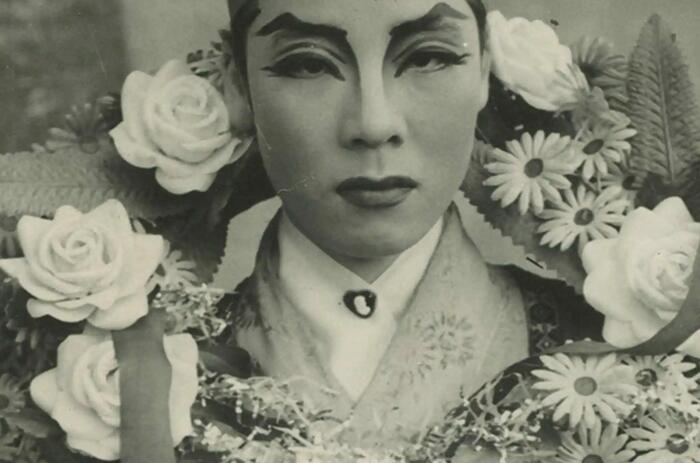
The Ford Foundation Gallery presented Catando Bajito: Incantations, the second movement of a year-long exhibition series that celebrates strategies for resistance in the wake of rising violence and incursions against bodily autonomy toward feminized bodies.
CANTANDO BAJITO: INCANTATIONS AT FORD FOUNDATION GALLERY
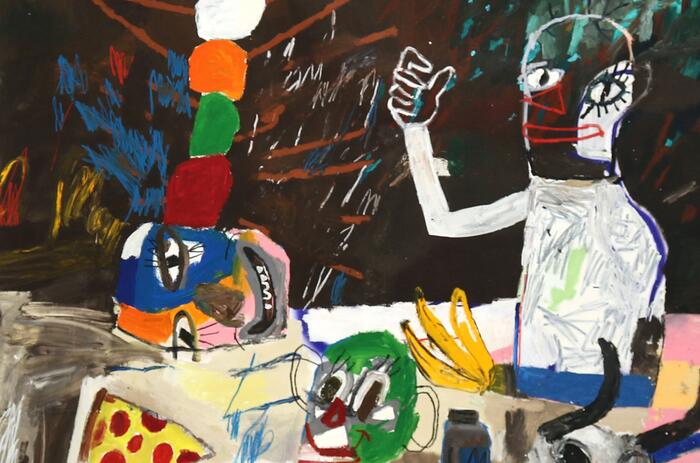
The powerful painting of Starsky Brines (Caracas, Venezuela, 1977) has in his most recent production the consolidation of one of the most intense expressions of the Latin American panorama. Collected under the accurate epigraph of Paisajes imposibles (Impossible Landscapes), the exhibition invites the spectator to let himself be impacted and submerged in a world as unreal and dreamlike as it is sometimes grotesque. These adjectives, more typical of the symptomatology of the society that underlies each of the Venezuelan's pictorial interpretations, seem to originate in the different angles that converge in Brines' universe.
HYBRID IDENTITY AND SOCIETY IN STARSKY BRINES
The powerful painting of Starsky Brines (Caracas, Venezuela, 1977) has in his most recent production the consolidation of one of the most intense expressions of the Latin American panorama. Collected under the accurate epigraph of Paisajes imposibles (Impossible Landscapes), the exhibition invites the spectator to let himself be impacted and submerged in a world as unreal and dreamlike as it is sometimes grotesque. These adjectives, more typical of the symptomatology of the society that underlies each of the Venezuelan's pictorial interpretations, seem to originate in the different angles that converge in Brines' universe.
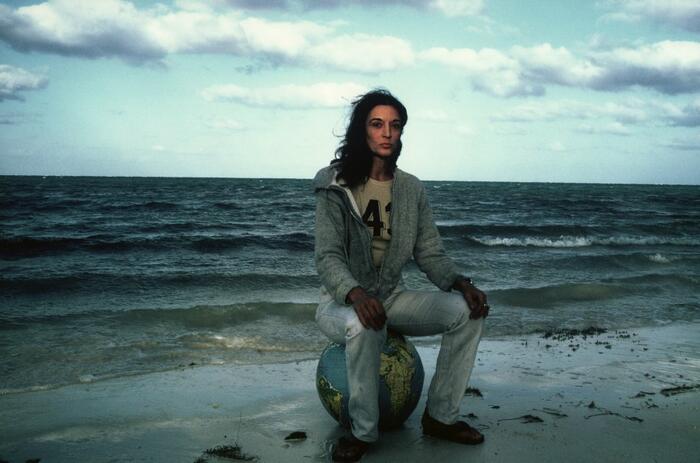
Marisol: a retrospective is an itinerant exhibition on view at the Buffalo AKG Art Museum, featuring the collection of artworks Marisol kept in her personal possession and left to the museum.
MARISOL – A RETROSPECTIVE
Marisol: a retrospective is an itinerant exhibition on view at the Buffalo AKG Art Museum, featuring the collection of artworks Marisol kept in her personal possession and left to the museum.
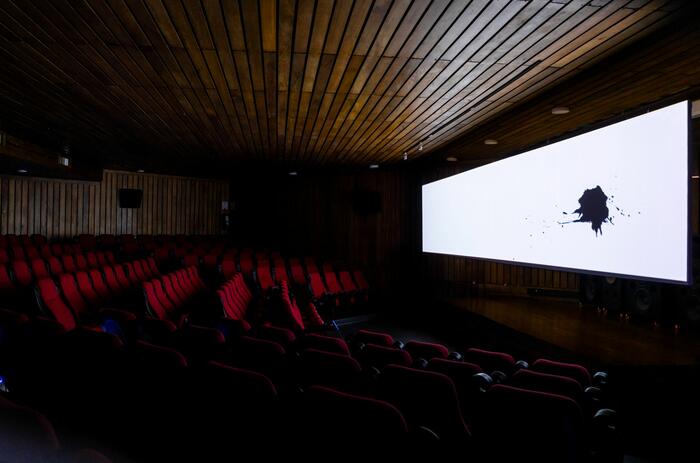
Cronotopías at the Museo de Arte Moderno de Bogotá (MAMBO) is the first institutional retrospective in Colombia dedicated to the visionary work of Argentinean artist Silvia Rivas. Since the late 1990s, Rivas has explored the expressive possibilities of expanded cinema, pushing the boundaries of video as a medium and creating multimedia and immersive environments. The exhibition is curated by Eugenio Viola.
SILVIA RIVAS AND THE LIMITS BETWEEN TIME AND SPACE
Cronotopías at the Museo de Arte Moderno de Bogotá (MAMBO) is the first institutional retrospective in Colombia dedicated to the visionary work of Argentinean artist Silvia Rivas. Since the late 1990s, Rivas has explored the expressive possibilities of expanded cinema, pushing the boundaries of video as a medium and creating multimedia and immersive environments. The exhibition is curated by Eugenio Viola.
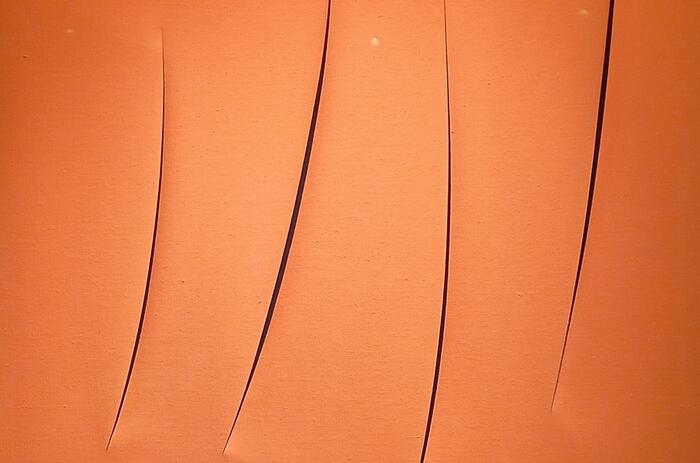
Lucio Fontana made one of the most extraordinary and radical gestures of modern art in 1958 when he cut the surface of a monochromatic canvas with a razor blade. The exhibition “Il y a eu un futur- Un Futuro c'é stato” at the Musée Soulage, Rodez, revisits the legacy of this artist and offers a survey of his entire oeuvre, before and after the war, in Argentina and Italy.
LUCIO FONTANA. IL Y A BIEN EU UN FUTUR - UN FUTURO C'É STATO
Lucio Fontana made one of the most extraordinary and radical gestures of modern art in 1958 when he cut the surface of a monochromatic canvas with a razor blade. The exhibition “Il y a eu un futur- Un Futuro c'é stato” at the Musée Soulage, Rodez, revisits the legacy of this artist and offers a survey of his entire oeuvre, before and after the war, in Argentina and Italy.

By Álvaro de Benito
The Madrid branch of La Cometa gallery presents during July the work of eight of its Ibero-American artists in a group show that delves into different languages and techniques, from ceramics to painting, and also includes dialogues with architecture and other productions. Three of those represented come from Spain, while of the five American representatives, four are Colombian and one is Cuban, which brings a representative vision of the gallery's artistic proposal closer to the spectator.

Widline Cadet (Pétion-Ville, Haiti, 1992) brings together in her life experience several of the aspects and themes that, perhaps, have inspired more production among all those curatorial lines with more presence. Her biography, constructed through childhood memories, the environment of a generation and a country marked by its own strong culture or the phenomena of emigration, constitutes the framework in which the photographer develops the practical integrity of her work.
MEMORY AND DIASPORA IN WIDLINE CADET
Widline Cadet (Pétion-Ville, Haiti, 1992) brings together in her life experience several of the aspects and themes that, perhaps, have inspired more production among all those curatorial lines with more presence. Her biography, constructed through childhood memories, the environment of a generation and a country marked by its own strong culture or the phenomena of emigration, constitutes the framework in which the photographer develops the practical integrity of her work.

All sauce, No shrimp is Sophie Ullrich’s anticipated solo exhibition at Piero Atchugarry. The artist presented a new collection of site-specific paintings and sculptures that entwines modern folklore and scientific inquiry.
AN UNDERWATER KINGDOM – SOPHIE ULLRICH EN PIERO ATCHUGARRY

Kasmin gallery presented Mundo de Julia, an exhibition of ceramic sculpture by Julia Isídrez. This is the artist’s first solo exhibition in the United States and runs concurrently with Isídrez’s presentation in Stranieri Ovunque – Foreigners Everywhere, the 60th International Art Exhibition of La Biennale di Venezia curated by Adriano Pedrosa.

The Ford Foundation Gallery presented Catando Bajito: Incantations, the second movement of a year-long exhibition series that celebrates strategies for resistance in the wake of rising violence and incursions against bodily autonomy toward feminized bodies.
CANTANDO BAJITO: INCANTATIONS AT FORD FOUNDATION GALLERY

The powerful painting of Starsky Brines (Caracas, Venezuela, 1977) has in his most recent production the consolidation of one of the most intense expressions of the Latin American panorama. Collected under the accurate epigraph of Paisajes imposibles (Impossible Landscapes), the exhibition invites the spectator to let himself be impacted and submerged in a world as unreal and dreamlike as it is sometimes grotesque. These adjectives, more typical of the symptomatology of the society that underlies each of the Venezuelan's pictorial interpretations, seem to originate in the different angles that converge in Brines' universe.
HYBRID IDENTITY AND SOCIETY IN STARSKY BRINES
The powerful painting of Starsky Brines (Caracas, Venezuela, 1977) has in his most recent production the consolidation of one of the most intense expressions of the Latin American panorama. Collected under the accurate epigraph of Paisajes imposibles (Impossible Landscapes), the exhibition invites the spectator to let himself be impacted and submerged in a world as unreal and dreamlike as it is sometimes grotesque. These adjectives, more typical of the symptomatology of the society that underlies each of the Venezuelan's pictorial interpretations, seem to originate in the different angles that converge in Brines' universe.

Marisol: a retrospective is an itinerant exhibition on view at the Buffalo AKG Art Museum, featuring the collection of artworks Marisol kept in her personal possession and left to the museum.
MARISOL – A RETROSPECTIVE
Marisol: a retrospective is an itinerant exhibition on view at the Buffalo AKG Art Museum, featuring the collection of artworks Marisol kept in her personal possession and left to the museum.

Cronotopías at the Museo de Arte Moderno de Bogotá (MAMBO) is the first institutional retrospective in Colombia dedicated to the visionary work of Argentinean artist Silvia Rivas. Since the late 1990s, Rivas has explored the expressive possibilities of expanded cinema, pushing the boundaries of video as a medium and creating multimedia and immersive environments. The exhibition is curated by Eugenio Viola.
SILVIA RIVAS AND THE LIMITS BETWEEN TIME AND SPACE
Cronotopías at the Museo de Arte Moderno de Bogotá (MAMBO) is the first institutional retrospective in Colombia dedicated to the visionary work of Argentinean artist Silvia Rivas. Since the late 1990s, Rivas has explored the expressive possibilities of expanded cinema, pushing the boundaries of video as a medium and creating multimedia and immersive environments. The exhibition is curated by Eugenio Viola.

Lucio Fontana made one of the most extraordinary and radical gestures of modern art in 1958 when he cut the surface of a monochromatic canvas with a razor blade. The exhibition “Il y a eu un futur- Un Futuro c'é stato” at the Musée Soulage, Rodez, revisits the legacy of this artist and offers a survey of his entire oeuvre, before and after the war, in Argentina and Italy.
LUCIO FONTANA. IL Y A BIEN EU UN FUTUR - UN FUTURO C'É STATO
Lucio Fontana made one of the most extraordinary and radical gestures of modern art in 1958 when he cut the surface of a monochromatic canvas with a razor blade. The exhibition “Il y a eu un futur- Un Futuro c'é stato” at the Musée Soulage, Rodez, revisits the legacy of this artist and offers a survey of his entire oeuvre, before and after the war, in Argentina and Italy.

By Álvaro de Benito
The Madrid branch of La Cometa gallery presents during July the work of eight of its Ibero-American artists in a group show that delves into different languages and techniques, from ceramics to painting, and also includes dialogues with architecture and other productions. Three of those represented come from Spain, while of the five American representatives, four are Colombian and one is Cuban, which brings a representative vision of the gallery's artistic proposal closer to the spectator.

Widline Cadet (Pétion-Ville, Haiti, 1992) brings together in her life experience several of the aspects and themes that, perhaps, have inspired more production among all those curatorial lines with more presence. Her biography, constructed through childhood memories, the environment of a generation and a country marked by its own strong culture or the phenomena of emigration, constitutes the framework in which the photographer develops the practical integrity of her work.
MEMORY AND DIASPORA IN WIDLINE CADET
Widline Cadet (Pétion-Ville, Haiti, 1992) brings together in her life experience several of the aspects and themes that, perhaps, have inspired more production among all those curatorial lines with more presence. Her biography, constructed through childhood memories, the environment of a generation and a country marked by its own strong culture or the phenomena of emigration, constitutes the framework in which the photographer develops the practical integrity of her work.

All sauce, No shrimp is Sophie Ullrich’s anticipated solo exhibition at Piero Atchugarry. The artist presented a new collection of site-specific paintings and sculptures that entwines modern folklore and scientific inquiry.
AN UNDERWATER KINGDOM – SOPHIE ULLRICH EN PIERO ATCHUGARRY

Kasmin gallery presented Mundo de Julia, an exhibition of ceramic sculpture by Julia Isídrez. This is the artist’s first solo exhibition in the United States and runs concurrently with Isídrez’s presentation in Stranieri Ovunque – Foreigners Everywhere, the 60th International Art Exhibition of La Biennale di Venezia curated by Adriano Pedrosa.

The Ford Foundation Gallery presented Catando Bajito: Incantations, the second movement of a year-long exhibition series that celebrates strategies for resistance in the wake of rising violence and incursions against bodily autonomy toward feminized bodies.
CANTANDO BAJITO: INCANTATIONS AT FORD FOUNDATION GALLERY

The powerful painting of Starsky Brines (Caracas, Venezuela, 1977) has in his most recent production the consolidation of one of the most intense expressions of the Latin American panorama. Collected under the accurate epigraph of Paisajes imposibles (Impossible Landscapes), the exhibition invites the spectator to let himself be impacted and submerged in a world as unreal and dreamlike as it is sometimes grotesque. These adjectives, more typical of the symptomatology of the society that underlies each of the Venezuelan's pictorial interpretations, seem to originate in the different angles that converge in Brines' universe.
HYBRID IDENTITY AND SOCIETY IN STARSKY BRINES
The powerful painting of Starsky Brines (Caracas, Venezuela, 1977) has in his most recent production the consolidation of one of the most intense expressions of the Latin American panorama. Collected under the accurate epigraph of Paisajes imposibles (Impossible Landscapes), the exhibition invites the spectator to let himself be impacted and submerged in a world as unreal and dreamlike as it is sometimes grotesque. These adjectives, more typical of the symptomatology of the society that underlies each of the Venezuelan's pictorial interpretations, seem to originate in the different angles that converge in Brines' universe.

Marisol: a retrospective is an itinerant exhibition on view at the Buffalo AKG Art Museum, featuring the collection of artworks Marisol kept in her personal possession and left to the museum.
MARISOL – A RETROSPECTIVE
Marisol: a retrospective is an itinerant exhibition on view at the Buffalo AKG Art Museum, featuring the collection of artworks Marisol kept in her personal possession and left to the museum.

Cronotopías at the Museo de Arte Moderno de Bogotá (MAMBO) is the first institutional retrospective in Colombia dedicated to the visionary work of Argentinean artist Silvia Rivas. Since the late 1990s, Rivas has explored the expressive possibilities of expanded cinema, pushing the boundaries of video as a medium and creating multimedia and immersive environments. The exhibition is curated by Eugenio Viola.
SILVIA RIVAS AND THE LIMITS BETWEEN TIME AND SPACE
Cronotopías at the Museo de Arte Moderno de Bogotá (MAMBO) is the first institutional retrospective in Colombia dedicated to the visionary work of Argentinean artist Silvia Rivas. Since the late 1990s, Rivas has explored the expressive possibilities of expanded cinema, pushing the boundaries of video as a medium and creating multimedia and immersive environments. The exhibition is curated by Eugenio Viola.

Lucio Fontana made one of the most extraordinary and radical gestures of modern art in 1958 when he cut the surface of a monochromatic canvas with a razor blade. The exhibition “Il y a eu un futur- Un Futuro c'é stato” at the Musée Soulage, Rodez, revisits the legacy of this artist and offers a survey of his entire oeuvre, before and after the war, in Argentina and Italy.
LUCIO FONTANA. IL Y A BIEN EU UN FUTUR - UN FUTURO C'É STATO
Lucio Fontana made one of the most extraordinary and radical gestures of modern art in 1958 when he cut the surface of a monochromatic canvas with a razor blade. The exhibition “Il y a eu un futur- Un Futuro c'é stato” at the Musée Soulage, Rodez, revisits the legacy of this artist and offers a survey of his entire oeuvre, before and after the war, in Argentina and Italy.

By Álvaro de Benito
The Madrid branch of La Cometa gallery presents during July the work of eight of its Ibero-American artists in a group show that delves into different languages and techniques, from ceramics to painting, and also includes dialogues with architecture and other productions. Three of those represented come from Spain, while of the five American representatives, four are Colombian and one is Cuban, which brings a representative vision of the gallery's artistic proposal closer to the spectator.

Widline Cadet (Pétion-Ville, Haiti, 1992) brings together in her life experience several of the aspects and themes that, perhaps, have inspired more production among all those curatorial lines with more presence. Her biography, constructed through childhood memories, the environment of a generation and a country marked by its own strong culture or the phenomena of emigration, constitutes the framework in which the photographer develops the practical integrity of her work.
MEMORY AND DIASPORA IN WIDLINE CADET
Widline Cadet (Pétion-Ville, Haiti, 1992) brings together in her life experience several of the aspects and themes that, perhaps, have inspired more production among all those curatorial lines with more presence. Her biography, constructed through childhood memories, the environment of a generation and a country marked by its own strong culture or the phenomena of emigration, constitutes the framework in which the photographer develops the practical integrity of her work.

All sauce, No shrimp is Sophie Ullrich’s anticipated solo exhibition at Piero Atchugarry. The artist presented a new collection of site-specific paintings and sculptures that entwines modern folklore and scientific inquiry.
AN UNDERWATER KINGDOM – SOPHIE ULLRICH EN PIERO ATCHUGARRY

Kasmin gallery presented Mundo de Julia, an exhibition of ceramic sculpture by Julia Isídrez. This is the artist’s first solo exhibition in the United States and runs concurrently with Isídrez’s presentation in Stranieri Ovunque – Foreigners Everywhere, the 60th International Art Exhibition of La Biennale di Venezia curated by Adriano Pedrosa.

The Ford Foundation Gallery presented Catando Bajito: Incantations, the second movement of a year-long exhibition series that celebrates strategies for resistance in the wake of rising violence and incursions against bodily autonomy toward feminized bodies.
CANTANDO BAJITO: INCANTATIONS AT FORD FOUNDATION GALLERY

The powerful painting of Starsky Brines (Caracas, Venezuela, 1977) has in his most recent production the consolidation of one of the most intense expressions of the Latin American panorama. Collected under the accurate epigraph of Paisajes imposibles (Impossible Landscapes), the exhibition invites the spectator to let himself be impacted and submerged in a world as unreal and dreamlike as it is sometimes grotesque. These adjectives, more typical of the symptomatology of the society that underlies each of the Venezuelan's pictorial interpretations, seem to originate in the different angles that converge in Brines' universe.
HYBRID IDENTITY AND SOCIETY IN STARSKY BRINES
The powerful painting of Starsky Brines (Caracas, Venezuela, 1977) has in his most recent production the consolidation of one of the most intense expressions of the Latin American panorama. Collected under the accurate epigraph of Paisajes imposibles (Impossible Landscapes), the exhibition invites the spectator to let himself be impacted and submerged in a world as unreal and dreamlike as it is sometimes grotesque. These adjectives, more typical of the symptomatology of the society that underlies each of the Venezuelan's pictorial interpretations, seem to originate in the different angles that converge in Brines' universe.

Marisol: a retrospective is an itinerant exhibition on view at the Buffalo AKG Art Museum, featuring the collection of artworks Marisol kept in her personal possession and left to the museum.
MARISOL – A RETROSPECTIVE
Marisol: a retrospective is an itinerant exhibition on view at the Buffalo AKG Art Museum, featuring the collection of artworks Marisol kept in her personal possession and left to the museum.

Cronotopías at the Museo de Arte Moderno de Bogotá (MAMBO) is the first institutional retrospective in Colombia dedicated to the visionary work of Argentinean artist Silvia Rivas. Since the late 1990s, Rivas has explored the expressive possibilities of expanded cinema, pushing the boundaries of video as a medium and creating multimedia and immersive environments. The exhibition is curated by Eugenio Viola.
SILVIA RIVAS AND THE LIMITS BETWEEN TIME AND SPACE
Cronotopías at the Museo de Arte Moderno de Bogotá (MAMBO) is the first institutional retrospective in Colombia dedicated to the visionary work of Argentinean artist Silvia Rivas. Since the late 1990s, Rivas has explored the expressive possibilities of expanded cinema, pushing the boundaries of video as a medium and creating multimedia and immersive environments. The exhibition is curated by Eugenio Viola.

Lucio Fontana made one of the most extraordinary and radical gestures of modern art in 1958 when he cut the surface of a monochromatic canvas with a razor blade. The exhibition “Il y a eu un futur- Un Futuro c'é stato” at the Musée Soulage, Rodez, revisits the legacy of this artist and offers a survey of his entire oeuvre, before and after the war, in Argentina and Italy.
LUCIO FONTANA. IL Y A BIEN EU UN FUTUR - UN FUTURO C'É STATO
Lucio Fontana made one of the most extraordinary and radical gestures of modern art in 1958 when he cut the surface of a monochromatic canvas with a razor blade. The exhibition “Il y a eu un futur- Un Futuro c'é stato” at the Musée Soulage, Rodez, revisits the legacy of this artist and offers a survey of his entire oeuvre, before and after the war, in Argentina and Italy.

By Álvaro de Benito
The Madrid branch of La Cometa gallery presents during July the work of eight of its Ibero-American artists in a group show that delves into different languages and techniques, from ceramics to painting, and also includes dialogues with architecture and other productions. Three of those represented come from Spain, while of the five American representatives, four are Colombian and one is Cuban, which brings a representative vision of the gallery's artistic proposal closer to the spectator.

Widline Cadet (Pétion-Ville, Haiti, 1992) brings together in her life experience several of the aspects and themes that, perhaps, have inspired more production among all those curatorial lines with more presence. Her biography, constructed through childhood memories, the environment of a generation and a country marked by its own strong culture or the phenomena of emigration, constitutes the framework in which the photographer develops the practical integrity of her work.
MEMORY AND DIASPORA IN WIDLINE CADET
Widline Cadet (Pétion-Ville, Haiti, 1992) brings together in her life experience several of the aspects and themes that, perhaps, have inspired more production among all those curatorial lines with more presence. Her biography, constructed through childhood memories, the environment of a generation and a country marked by its own strong culture or the phenomena of emigration, constitutes the framework in which the photographer develops the practical integrity of her work.

All sauce, No shrimp is Sophie Ullrich’s anticipated solo exhibition at Piero Atchugarry. The artist presented a new collection of site-specific paintings and sculptures that entwines modern folklore and scientific inquiry.
AN UNDERWATER KINGDOM – SOPHIE ULLRICH EN PIERO ATCHUGARRY

Kasmin gallery presented Mundo de Julia, an exhibition of ceramic sculpture by Julia Isídrez. This is the artist’s first solo exhibition in the United States and runs concurrently with Isídrez’s presentation in Stranieri Ovunque – Foreigners Everywhere, the 60th International Art Exhibition of La Biennale di Venezia curated by Adriano Pedrosa.

The Ford Foundation Gallery presented Catando Bajito: Incantations, the second movement of a year-long exhibition series that celebrates strategies for resistance in the wake of rising violence and incursions against bodily autonomy toward feminized bodies.
CANTANDO BAJITO: INCANTATIONS AT FORD FOUNDATION GALLERY

The powerful painting of Starsky Brines (Caracas, Venezuela, 1977) has in his most recent production the consolidation of one of the most intense expressions of the Latin American panorama. Collected under the accurate epigraph of Paisajes imposibles (Impossible Landscapes), the exhibition invites the spectator to let himself be impacted and submerged in a world as unreal and dreamlike as it is sometimes grotesque. These adjectives, more typical of the symptomatology of the society that underlies each of the Venezuelan's pictorial interpretations, seem to originate in the different angles that converge in Brines' universe.
HYBRID IDENTITY AND SOCIETY IN STARSKY BRINES
The powerful painting of Starsky Brines (Caracas, Venezuela, 1977) has in his most recent production the consolidation of one of the most intense expressions of the Latin American panorama. Collected under the accurate epigraph of Paisajes imposibles (Impossible Landscapes), the exhibition invites the spectator to let himself be impacted and submerged in a world as unreal and dreamlike as it is sometimes grotesque. These adjectives, more typical of the symptomatology of the society that underlies each of the Venezuelan's pictorial interpretations, seem to originate in the different angles that converge in Brines' universe.

Marisol: a retrospective is an itinerant exhibition on view at the Buffalo AKG Art Museum, featuring the collection of artworks Marisol kept in her personal possession and left to the museum.
MARISOL – A RETROSPECTIVE
Marisol: a retrospective is an itinerant exhibition on view at the Buffalo AKG Art Museum, featuring the collection of artworks Marisol kept in her personal possession and left to the museum.

Cronotopías at the Museo de Arte Moderno de Bogotá (MAMBO) is the first institutional retrospective in Colombia dedicated to the visionary work of Argentinean artist Silvia Rivas. Since the late 1990s, Rivas has explored the expressive possibilities of expanded cinema, pushing the boundaries of video as a medium and creating multimedia and immersive environments. The exhibition is curated by Eugenio Viola.
SILVIA RIVAS AND THE LIMITS BETWEEN TIME AND SPACE
Cronotopías at the Museo de Arte Moderno de Bogotá (MAMBO) is the first institutional retrospective in Colombia dedicated to the visionary work of Argentinean artist Silvia Rivas. Since the late 1990s, Rivas has explored the expressive possibilities of expanded cinema, pushing the boundaries of video as a medium and creating multimedia and immersive environments. The exhibition is curated by Eugenio Viola.

Lucio Fontana made one of the most extraordinary and radical gestures of modern art in 1958 when he cut the surface of a monochromatic canvas with a razor blade. The exhibition “Il y a eu un futur- Un Futuro c'é stato” at the Musée Soulage, Rodez, revisits the legacy of this artist and offers a survey of his entire oeuvre, before and after the war, in Argentina and Italy.
LUCIO FONTANA. IL Y A BIEN EU UN FUTUR - UN FUTURO C'É STATO
Lucio Fontana made one of the most extraordinary and radical gestures of modern art in 1958 when he cut the surface of a monochromatic canvas with a razor blade. The exhibition “Il y a eu un futur- Un Futuro c'é stato” at the Musée Soulage, Rodez, revisits the legacy of this artist and offers a survey of his entire oeuvre, before and after the war, in Argentina and Italy.




